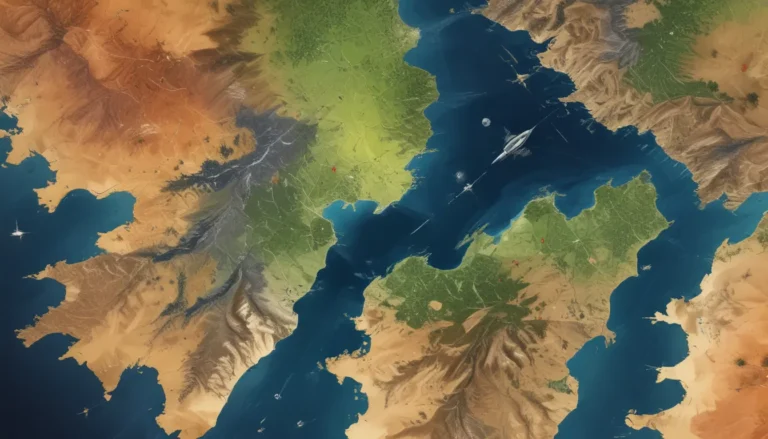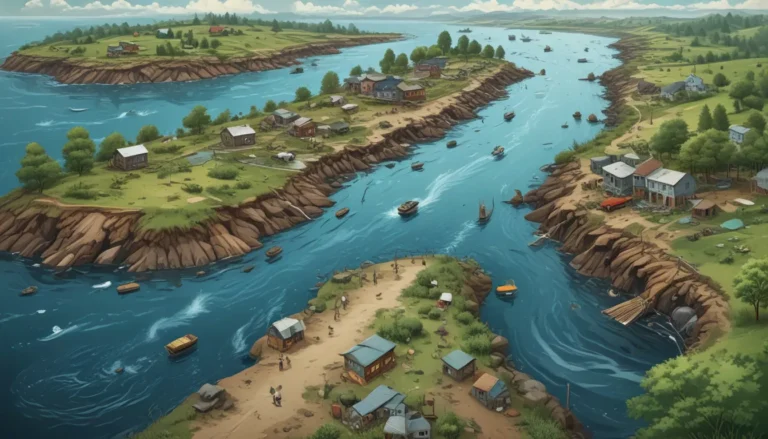A Note About Images: The images used in our articles are for illustration purposes only and may not exactly match the content. They are meant to engage readers, but the text should be relied upon for accurate information.
Cyclones, also known as hurricanes or typhoons, are awe-inspiring natural phenomena that have captivated human interest for centuries. These powerful swirling storms, characterized by intense winds, heavy rainfall, and destructive impacts, continue to intrigue and mesmerize us with their enigmatic nature. In this comprehensive guide, we will delve into 15 intriguing facts about cyclones, shedding light on their formation, behavior, and the remarkable forces at play within these incredible weather systems.
The Birth of Cyclones: Unraveling the Mystery
Cyclones, whether called hurricanes or typhoons depending on the region, are massive swirling storms that originate over warm ocean waters. These intense weather systems are distinguished by low-pressure centers and winds exceeding 74 miles per hour, creating a vortex of devastating power.
The Powerful Forces at Work: Understanding Cyclone’s Fury
Cyclones are capable of wreaking havoc of epic proportions, unleashing destructive storm surges, heavy rainfall, and violent winds that can obliterate entire coastlines. Their sheer force and ferocity leave a path of devastation in their wake, making them one of the most formidable natural disasters on Earth.
- Cyclones And Their Fury:
- Devastating storm surges
- Heavy rainfall leading to flooding
- Violent winds causing destruction
Enigmatically Spinning: The Dance of Cyclones
A fascinating phenomenon of cyclones is their rotation direction. In the Northern Hemisphere, cyclones swirl counterclockwise, while in the Southern Hemisphere, they move in a clockwise direction. This intriguing behavior is a result of the Coriolis effect induced by the Earth’s rotation.
Classifying Cyclones: Unveiling the Categories
Cyclones are categorized based on their wind speed, with various scales designed to classify their intensity. The Saffir-Simpson Hurricane Wind Scale, consisting of five categories, and the Beaufort scale, which categorizes cyclones based on wind speeds and their impact on land and sea, provide valuable insights into the power and destructiveness of these storms.
The Mysterious Eye of the Storm: Unveiling the Center
Cyclones possess a distinct feature known as the eye, a serene and clear center amidst the chaos of the storm. Surrounding the eye is the eyewall, a ring of intense thunderstorms where the strongest winds and heaviest rainfall occur, showcasing the dynamic and paradoxical nature of cyclones.
The Elemental Dance: Warmth, Cold, and Cyclones
The energy source of cyclones lies in the warm and moist tropical ocean waters, where warm air rises from the surface and cooler air rushes in to replace it, perpetuating a cycle of energy that fuels the storm’s intensity. This intricate dance between warm and cold air contributes to the powerful nature of cyclones.
Global Cyclones: A Worldwide Phenomenon
Cyclones manifest in various regions across the globe, including the Atlantic, Pacific, and Indian Oceans, as well as the Southern Hemisphere. Depending on their location, they can be referred to as hurricanes in the Atlantic or typhoons in the Pacific, highlighting the widespread impact of these formidable storms.
The Unholy Trinity of Hazards: Unveiling the Triple Threat
Cyclones bring about three primary hazards: strong winds, torrential rainfall, and storm surges. The combination of these elements can lead to catastrophic flooding, landslides, and widespread destruction, underscoring the immense destructive potential of cyclones.
Enigmatic Records: The Pinnacle of Cyclone Power
The strongest cyclone ever recorded was Typhoon Tip, which made landfall in the northwest Pacific Ocean. With a diameter exceeding 1,300 kilometers and wind speeds reaching 190 miles per hour, Typhoon Tip stands as the largest and most intense tropical cyclone in recorded history, showcasing the unparalleled power of cyclones.
The Naming Game: Understanding Cyclone Identification
Cyclones are named to facilitate identification and communication during severe weather events. Meteorological organizations worldwide adhere to specific naming protocols, using predetermined lists of names or adopting a rotational naming system to track and categorize cyclones with ease.
Forecasting the Unpredictable: The Art of Prediction
Meteorologists employ advanced techniques and data to forecast the path and intensity of cyclones, yet the rapid and unpredictable nature of these storms poses challenges in accurate forecasting. Despite these obstacles, continuous efforts are made to enhance forecasting capabilities and minimize the impact of cyclones.
Climate Change: The Impact on Cyclones
Climate change may influence the frequency and intensity of cyclones, with warmer ocean temperatures providing additional energy for storm development. This could potentially result in stronger and more frequent cyclones in certain regions, emphasizing the critical role of climate change in shaping the behavior of cyclones.
Hurricane Hunters: Brave Explorers of the Storm
To gather crucial data on cyclones, specialized aircraft known as hurricane hunters venture into the eye of the storm. These courageous individuals collect essential measurements such as wind speed, air pressure, and temperature, contributing to improved forecasting and a better understanding of cyclones.
The Aftermath: Rebuilding Amidst Destruction
Cyclones leave a trail of devastation in their path, causing significant infrastructure damage, displacing communities, and claiming lives. The recovery and reconstruction process following a cyclone can be arduous and lengthy, requiring support and assistance from both local and international communities to aid in rebuilding efforts.
Human Resilience: Triumph Over Adversity
Despite the havoc wreaked by cyclones, humanity has demonstrated remarkable resilience in the face of these natural disasters. Technological advancements, improved disaster preparedness, and effective evacuation procedures have played a pivotal role in saving lives and mitigating the impact of cyclones, showcasing the strength and adaptability of human beings in the face of adversity.
In conclusion, cyclones remain a captivating subject that incites both fear and fascination due to their immense power, unpredictability, and widespread devastation. By delving into the enigmatic facts surrounding cyclones, we gain a deeper understanding of these awe-inspiring natural phenomena and the imperative need for preparedness and resilience in mitigating the effects of these formidable storms.
FAQs
- Q: What causes a cyclone to form?
-
A: Cyclones form when warm, moist air rises over the ocean, creating low pressure that spirals into a cyclonic storm.
-
Q: How are cyclones classified?
-
A: Cyclones are classified based on their wind speeds, with varying categories indicating their intensity and destructive potential.
-
Q: How are cyclones named?
-
A: Cyclones are named by meteorological organizations using predetermined lists of names, aiding in identification and tracking.
-
Q: Which regions are most affected by cyclones?
-
A: Cyclones predominantly occur in tropical and subtropical regions, including the Atlantic, Pacific, and Indian Oceans, where they unleash their fury.
-
Q: How do we predict and track cyclones?
-
A: Meteorologists utilize advanced monitoring systems, satellite imagery, and computer models to track cyclones, enabling timely warnings and evacuation protocols to be issued.
-
Q: What precautions can individuals and communities take?
- A: Staying informed about cyclone warnings, securing property, creating emergency kits, and having an evacuation plan are vital precautions to minimize the impact of cyclones and safeguard lives and property.
Our Commitment to Quality Information
Cyclones are extraordinary natural phenomena that intrigue and baffle us with their immense power and unpredictable nature. Through a shared commitment to delivering accurate and engaging content, we strive to provide you with valuable insights and knowledge about the world around us. Each fact shared on our platform is contributed by real users like you, ensuring a diverse array of information and perspectives that enrich and inform our understanding of cyclones and other natural wonders. Embrace the journey of exploration and discovery with us, as we navigate the mysteries of the natural world together.






